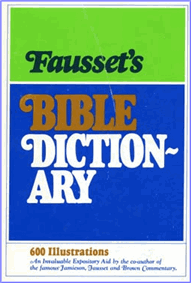Fausset's Bible Dictionary
A B C D E F G H I J K L M N O P Q R S T U V W X Y Z
Leaven
seor. A lump of old dough in high fermentation. As making it and leavening bread with it took time, unleavened bread was used in sudden emergencies (Genesis 18:6; Genesis 19:3). It was forbidden in all offerings to the Lord by fire (Leviticus 2:11; Leviticus 7:12). The Israelites on pain of death were to have none in their houses or in the land during Passover for seven days, from 14th Nisan (Exodus 12:15; Exodus 12:19; Exodus 12:39; Exodus 13:7; Exodus 23:18; Deuteronomy 16:3-4). Salt was its opposite, and was never to be absent from the altar burnt offering, representing the incorruptible imperishableness of Jehovah's covenant. Honey as liable to ferment also was excluded from the altar burnt offerings. Leaven reminded Israel of the haste with which they fled from Egypt, and of their sufferings, which answer to the insipidity of unleavened bread, "the bread of affliction."
Its prominent symbolical meaning was, it is bred of corruption and corrupts the mass with which it is mixed. Hence it represents "malice" (the evil habit) and "wickedness" (evil coming out in word and deed) as opposed to "sincerity" and "truth" (1 Corinthians 5:7). The Jews searched with extreme care their houses, to purge out every particle of leaven. So Christians ought to search their hearts and purge out every corruption (Psalm 139:23-24). It also symbolizes corrupt doctrine (Matthew 16:6). Another quality is its secretly penetrating and diffusive influence: 1 Corinthians 5:6, "a little leaven leaveneth the whole lump," the influence of one sinner corrupts many (Ecclesiastes 9:18); but in Galatians 5:9 a little legalism mixed with the gospel corrupts its purity. Though elsewhere used in a bad sense, leaven in Matthew 13:33 represents the gospel principle working silently "without observation" from within, until the whole is leavened, just as the mustard tree represents its diffusion externally; so "flesh," though usually in a bad sense, in Ezekiel 11:19 is in a good sense.
The decomposition of social elements, accompanying and providentially preparing the way for the gospel, makes the image appropriate. Leaven was allowed to be offered in the firstfruits and tithes (Deuteronomy 26:2; Deuteronomy 26:12; 2 Chronicles 31:5), the Pentecostal loaves (Leviticus 23:15; Leviticus 23:17), and the peace offering (Leviticus 7:13). See Leviticus 2:11 "as an oblation of firstfruits ye shall offer them (leaven and honey) unto the Lord, but they shall not be burnt on the altar for a sweet savour." In Amos 4:5 the leavened bread was "with the sacrifice of thanksgiving of the peace offerings," not with burnt offerings of animals on the altar. Perhaps however the command is ironical, "offer by burning (margin) a sacrifice ... with leaven" (which was forbidden), your very offerings being open insults to God.
Bibliography Information
Fausset, Andrew Robert M.A., D.D., "Definition for 'leaven' Fausset's Bible Dictionary".
bible-history.com - Fausset's; 1878.
Copyright Information
© Fausset's Bible Dictionary
Fausset's Bible Dictionary Home
Bible History Online Home
Bible Encyclopedia (ISBE)
Online Bible (KJV)
Naves Topical Bible
Smith's Bible Dictionary
Easton's Bible Dictionary
Schaff's Bible Dictionary
Fausset's Bible Dictionary
Matthew Henry Bible Commentary
Hitchcock's Bible Dictionary

Dr. A.R. Fausset
Popular and Trending:
Meaning and definition of fasting, what is fasting in the bible, fasting definition, why should I fast, the power of prayer and fasting, Location of Galilee, where was galilee in the bible?, fasting definition, Galilee region, cities of Galilee, Sea of Galilee, Definition of biblical fire, what is fire in the bible?, fire and brimstone, fire meaning, baking bread with fire, Definition of the biblical firmament in Genesis, what is the firmament in the bible?, was the firmament the third heaven, firmament meaning, did the firmament bring the flood of Noah?.
